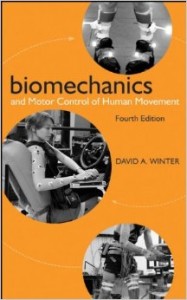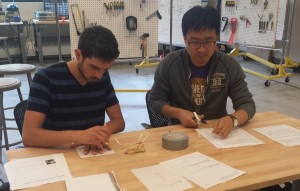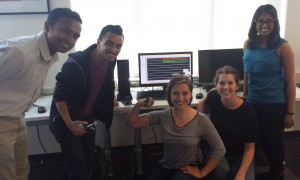Kat Steele presented at the International Society of Biomechanics Technical Group on Computer Simulation in Edinburgh, Scotland on July 11, 2015. This study quantifies how traditional methods for estimating muscle activity in musculoskeletal simulation (e.g., minimizing sum of squared muscle activations) fails to accurately predict muscle activity for individuals with cerebral palsy. This research will help to guide the development of new methods to quantify patient-specific changes in neuromuscular control.
Prototyping Challenge: Opening the Hand
Today we hosted a prototyping challenge at the CoMotion Makerspace with some of our partners from Seattle Pacific University. The focus of today’s challenge was to both introduce our new lab members to low-resolution prototyping and improve the design of our affordable hand exoskeleton for individuals with impaired hand function.

The challenge:
Individuals who have had a stroke or neurologic injury commonly lose the ability to open their hand. Physical and occupational therapy are the most common treatments and can lead to improvements in hand function with prolonged, focused practice. Exoskeletons and other robotic technology has been introduced, but these systems are typically expensive, bulky, and can only be used in the clinical environment. In this prototyping challenge, you will build and test low-resolution prototypes to explore how we might safely, comfortable, and affordably help to open the hand for individuals with neurologic disorders.
The group came up with some great ideas and designs (and some spectacular failures with important lessons). If you would like to try this prototyping challenge yourself, grab some prototyping supplies and work through our GUIDE.
B Blaser, S Burgstahler, KM Steele, (2015) “Including universal design in engineering courses to attract diverse students.” Proceedings of the American Society for Engineering Education

Paper at American Society of Engineering Education
Brianna Blaser and Kat Steele presented their paper, “Including universal design in engineering courses to attract diverse students” at the American Society for Engineering Education annual conference in Seattle, WA on June 17, 2015. This paper reported the results of a survey to current students with disabilities about their experiences in engineering classes and how accessibility and universal design may be incorporated into the engineering curriculum.
Abstract:
Research has shown that members of some groups, including women and people with disabilities, are particularly interested in how their fields of study, such as engineering, can improve the world around them. Teaching students about universal design (UD) and how it benefits individuals with disabilities has the potential to attract these students to engineering and encourage them to create products and environments that are accessible to and usable by individuals with a broad range of characteristics. In this paper, we present findings from an online discussion and site visits to engineering labs with students with disabilities. Based on these findings, we identify opportunities for including disability and UD topics in engineering curricula. Capstone or cornerstone engineering design classes are a natural fit for incorporating these concepts, but other engineering course can be enhanced with disability and UD content as well. We also present suggestions for applying UD to instruction in order to ensure that engineering courses are accessible to the widest audience possible. This investigation provides a foundation for using UD to broaden participation in engineering and training engineers who can design products and environments that address the diverse needs of society.
Welcome REU students!
We are welcoming three awesome undergraduate students to our lab this year. All three are participating in a Research Experience for Undergraduates (REU) with the NSF Center for Sensorimotor Neural Engineering.
- Lekha Anantuni is a rising senior in biomedical engineering from Arizona State University
- Albert Perez, Jr. is a rising sophomore in mechanical engineering from San Diego State University
- Sasha Portnova is a rising senior in mechanical engineering from UW
To introduce the crew to the lab, we had kick-off meetings today. After lunch at Aqua Verde we headed to the CSNE to an introduction and demo with electromyography (EMG) which will be critical for Lekha’s project. Later in the afternoon, our partners from Seattle Pacific University and the UW Division of Prosthetics & Orthotics stopped by for a kick-off meeting to discuss how Albert and Sasha can help to improve and test the design of open-source orthoses for individuals with impaired hand function.
For Science!
Finalist for David Winter Award
Dr. Steele has been selected as one of five finalists for the  David Winter Young Investigator Award at the International Society of Biomechanics. She will be presenting in the award session on Wednesday, July 15th at the conference in Glasgow. She will be presenting the results of her research on:
David Winter Young Investigator Award at the International Society of Biomechanics. She will be presenting in the award session on Wednesday, July 15th at the conference in Glasgow. She will be presenting the results of her research on:
Altered muscle synergies during gait in cerebral palsy are not due to altered kinematics or kinetics.



